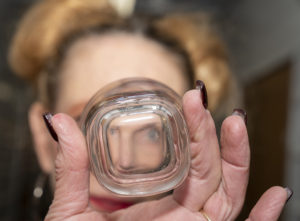 This month I experienced the honor of an interview for NerdWallet (really!) with Liz Weston, Associated Press and LA Times columnist. She welcomed my opinions on downsizing, especially for folks 50 plus years old, in regard to things in the dining room. We laughed and joked and shared much in common trying to give things to grown family members, particularly objects related to the ritual of DINING. Since Ms. Weston is a financial guru, her questions centered on the market forces that drove these values DOWN in the last 50 years.
This month I experienced the honor of an interview for NerdWallet (really!) with Liz Weston, Associated Press and LA Times columnist. She welcomed my opinions on downsizing, especially for folks 50 plus years old, in regard to things in the dining room. We laughed and joked and shared much in common trying to give things to grown family members, particularly objects related to the ritual of DINING. Since Ms. Weston is a financial guru, her questions centered on the market forces that drove these values DOWN in the last 50 years.
So I want to review some highlights of this dilemma. I’ve helped hundreds of clients see the reality of the market for the TYPE of DINING objects MY generation treasured —and are NOW most likely in STORAGE. And I offer you a short description of WHY such things are indeed in MY $300 a month storage locker. In other words, the market forces and reasons why certain objects (china, silver, crystal and linens) have become devalued.
The Dining Room
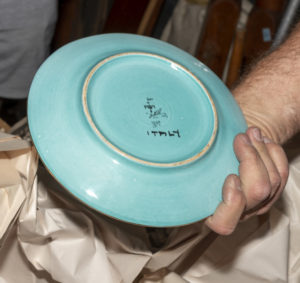 The most devalued genre of objects your kids do not want live in the DINING ROOM. Once houses contained such a place with a huge fine wood table only occasionally used. Today we do not DINE. Most newly built or updated homes do NOT feature a dining room. At one point this room became the heart of our households, as well as serving for all the things used and stored there. We owned CHINA CABINETS for FORMAL services of CHINA, as many as three to four different services for times of the year, and in fact, sometimes SPECIFIC china used for certain TIMES of the day. One of my clients inherited an Austrian porcelain TEA service, complete with small plates for tiny sandwiches and cakes, used in the mid to late afternoon in the early 20th century.
The most devalued genre of objects your kids do not want live in the DINING ROOM. Once houses contained such a place with a huge fine wood table only occasionally used. Today we do not DINE. Most newly built or updated homes do NOT feature a dining room. At one point this room became the heart of our households, as well as serving for all the things used and stored there. We owned CHINA CABINETS for FORMAL services of CHINA, as many as three to four different services for times of the year, and in fact, sometimes SPECIFIC china used for certain TIMES of the day. One of my clients inherited an Austrian porcelain TEA service, complete with small plates for tiny sandwiches and cakes, used in the mid to late afternoon in the early 20th century.
Today’s society no longer values fine china used for certain occasions because those FORMAL AND CODIFIED RITUALS are fast fading. We don’t have a dining ritual except for the most select holidays. My clients feel dismayed to find a fine service for 24 place setting worth under $500, if they even find a market for sales.
Historically civilizations ALWAYS practiced a ritual around consuming food, but this PHILOSOPHY AROUND GATHERING TO BREAK BREAD CHANGED. In my grandparent’s house we observed unspoken rituals:
- WHO, what female of what age group, cooked what.
- What gender did certain jobs: older men brought IN the main meat course, younger men took OUT the garbage.
- AGED BASED dining tables. Remember the kid’s table?
These rituals involved DINING objects
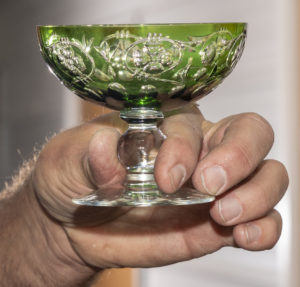 For example smaller child-sized sets of cutlery for the kid’s table. When a child got to use a sharper knife or a full-sized place setting it signaled their coming of age. Fine silver is valued for its silver content if it’s sterling. If it’s silver plate, forget it. But silverware isn’t valued because GOOD cutlery is reserved for GOOD guests upon HIGH holidays with certain age and gender limitations. The eldest man of the family usually reserved the right to wield a carving knife and sharpener. So, the market for fine cutlery went WAY DOWN.
For example smaller child-sized sets of cutlery for the kid’s table. When a child got to use a sharper knife or a full-sized place setting it signaled their coming of age. Fine silver is valued for its silver content if it’s sterling. If it’s silver plate, forget it. But silverware isn’t valued because GOOD cutlery is reserved for GOOD guests upon HIGH holidays with certain age and gender limitations. The eldest man of the family usually reserved the right to wield a carving knife and sharpener. So, the market for fine cutlery went WAY DOWN.
The philosophy of eating in tight family groups with certain status and gender specific signals changed, so the perception of the value of the objects involved in that ritual changed as well.
Think of the many TYPES of crystal glassware you might have owned:
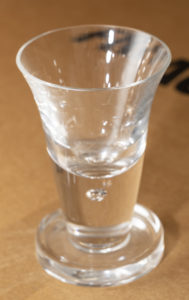 two types and sizes of wine glasses
two types and sizes of wine glasses- highball and cocktail glasses
- cordials
- spirit tumblers
- kid’s mugs and cups
- grandfather’s OWN whiskey glass that no one washed but grandmother
The list seems exhausting. That level of formality around what is sipped by whom at what time of day no longer exists. A can or a red plastic tumbler works well no matter time of day or setting…. Therefore these whole services of drinking objects dropped WAY down in value.
A WHY always lurks behind market forces. In this case the answer to the WHY lies in that we no longer value a ritual of drinking or eating with certain fine objects at a certain fine table at HOME. The ritual becomes different when one dines OUT. At a fine restaurant one expects to observe these rituals, but one doesn’t expect them at a friend’s house. This used to be the other way around. Home dining possessed a level marked by objects of status.
I despair when a client asks what they can do with FINE TABLE LINENS.
Even the BEST, usually made of real linen with real lace, are impossible to sell today. Another part of the degradation of the dining ritual. Once we considered covering a table a sign of respect and honor. Today we feel it unnecessary at home. Not to mention laundry chores, and who even OWNS an ironing board anymore? Recently when upgraded to a first-class seat on an airplane I felt bemused to find the cabin attendant covered my plastic tray with a white cloth. This ritual is fast fading, except as a nod to a past tradition, which signals “class.” When the tradition fades, the object becomes devalued.
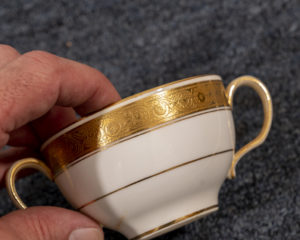 Stay tuned to my blog to learn more about the MOST advantageous arena for downsizing of such DINING accoutrements. I have a few suggestions, such as sell your dining linens to folks who sew bridal gowns…. and other unbelievable but true remedies for TOO MUCH DINING ROOM STUFF.
Stay tuned to my blog to learn more about the MOST advantageous arena for downsizing of such DINING accoutrements. I have a few suggestions, such as sell your dining linens to folks who sew bridal gowns…. and other unbelievable but true remedies for TOO MUCH DINING ROOM STUFF.